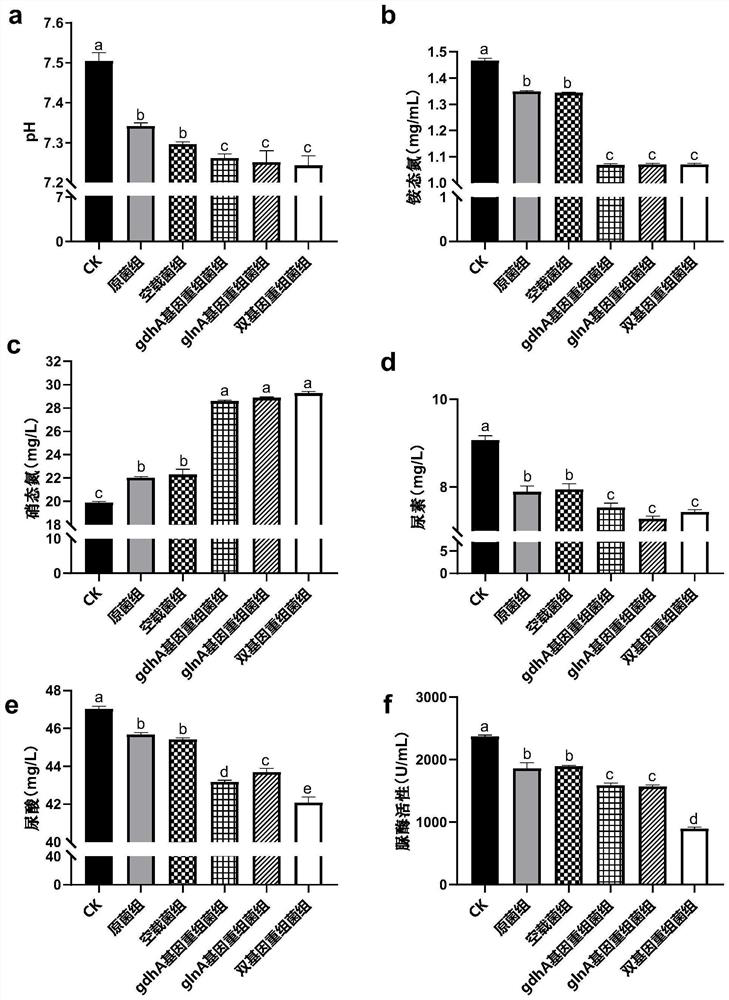Yeast recombinant bacterium and application thereof in reducing production of ammonia gas in caecum of laying hens
A technology of recombinant bacteria and yeast, applied in the biological field, can solve the problems of less probiotics and low ammonia emission reduction effect, and achieve the effects of easy cultivation, low cost, and reduced ammonia emission
- Summary
- Abstract
- Description
- Claims
- Application Information
AI Technical Summary
Problems solved by technology
Method used
Image
Examples
Embodiment 1
[0020] Embodiment 1: Construction of double-gene recombinant bacteria
[0021] (1) Vector selection and primer design: The yeast expression vector used is pPICZA. According to the multi-cloning site of the vector, the enzyme cutting sites that are not contained in the gdhA gene and glnA gene coding regions are used to determine the enzymes that can be added at both ends of the gene. Restriction sites. According to the gene sequences of gdhA gene and glnA gene, primers GDH(F), GDH(R) and GS(F), GS(R) were designed and synthesized by using Primer5 software. Add EcoR I and Kpn I restriction site sequences at the upstream and downstream of the gdhA gene, respectively, and add Kpn I and Not I restriction site sequences at the upstream and downstream of the glnA gene.
[0022] Table 1: Synthetic Primer Information
[0023]
[0024] (2) Using Enterococcus faecium and Bacillus coagulans as templates, using GDH(F) and GDH(R) as primers to synthesize the gdhA gene sequence, and usi...
Embodiment 2
[0035] Example 2: Functional detection of the double-gene recombinant bacteria constructed in Example 1
[0036] The double-gene recombinant bacteria obtained in Example 1 were inoculated in the YPDA liquid medium containing Zeocin, and cultivated for 1 day at 30° C. on a shaker at 200 rpm; Cultivate in a bottle at 30°C with a 200rpm shaker until the OD600 is 2-6; transfer the bacterial solution to a 50mL sterilized centrifuge tube, and collect the bacterial cells by centrifugation; transfer the collected bacterial cells to a 500mL Add methanol to the Erlenmeyer flask so that the concentration of methanol is 1%, and cultivate at 30° C. on a shaker at 200 rpm for 144 hours. Samples were taken every 24 hours and methanol was added to ensure a final concentration of 1%. After induced expression, the double-gene recombinant bacteria can effectively express glutamate dehydrogenase and glutamine synthetase, and the molecular weights of the expressed products are about 50kDa and 55k...
Embodiment 3
[0039] Example 3: The effect of the double-gene recombinant bacteria constructed in Example 1 on reducing ammonia emissions from the cecum of laying hens
[0040] Using 33-week-old Roman powder laying hens as the test material, and laying hen feed (Table 2) as the fermentation substrate (purchased from Huizhou Lefu Agricultural Technology Co., Ltd.), in vitro fermentation verification double-gene recombinant bacteria simulated the effect of laying hens. Effects of ammonia gas production in the cecal environment.
[0041] Table 2: Component composition and nutritional level of laying hen feed
[0042]
[0043] The test set up a blank group (CK), original bacteria group, empty bacteria group, gdhA gene recombinant bacteria, glnA gene recombinant bacteria and double gene recombinant bacteria groups, and each test group had 6 replicates (Table 3). The added bacterial strains are yeast original bacteria after induced expression, empty bacteria, gdhA gene recombinant bacteria, gln...
PUM
 Login to View More
Login to View More Abstract
Description
Claims
Application Information
 Login to View More
Login to View More - R&D Engineer
- R&D Manager
- IP Professional
- Industry Leading Data Capabilities
- Powerful AI technology
- Patent DNA Extraction
Browse by: Latest US Patents, China's latest patents, Technical Efficacy Thesaurus, Application Domain, Technology Topic, Popular Technical Reports.
© 2024 PatSnap. All rights reserved.Legal|Privacy policy|Modern Slavery Act Transparency Statement|Sitemap|About US| Contact US: help@patsnap.com










